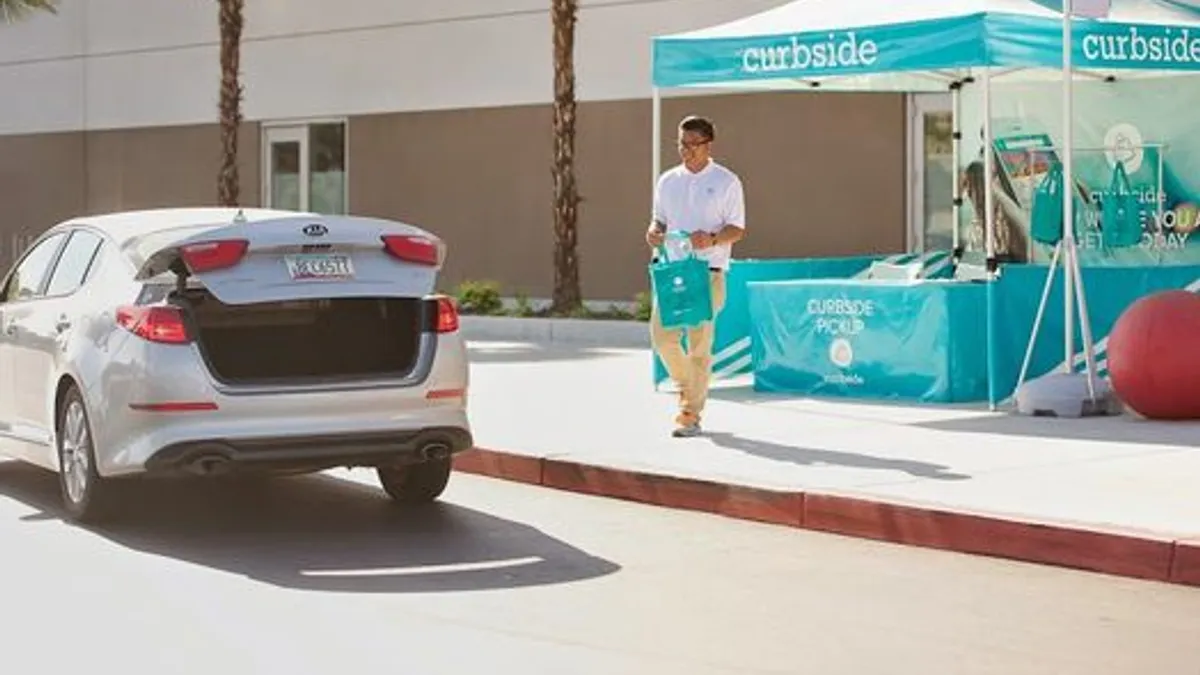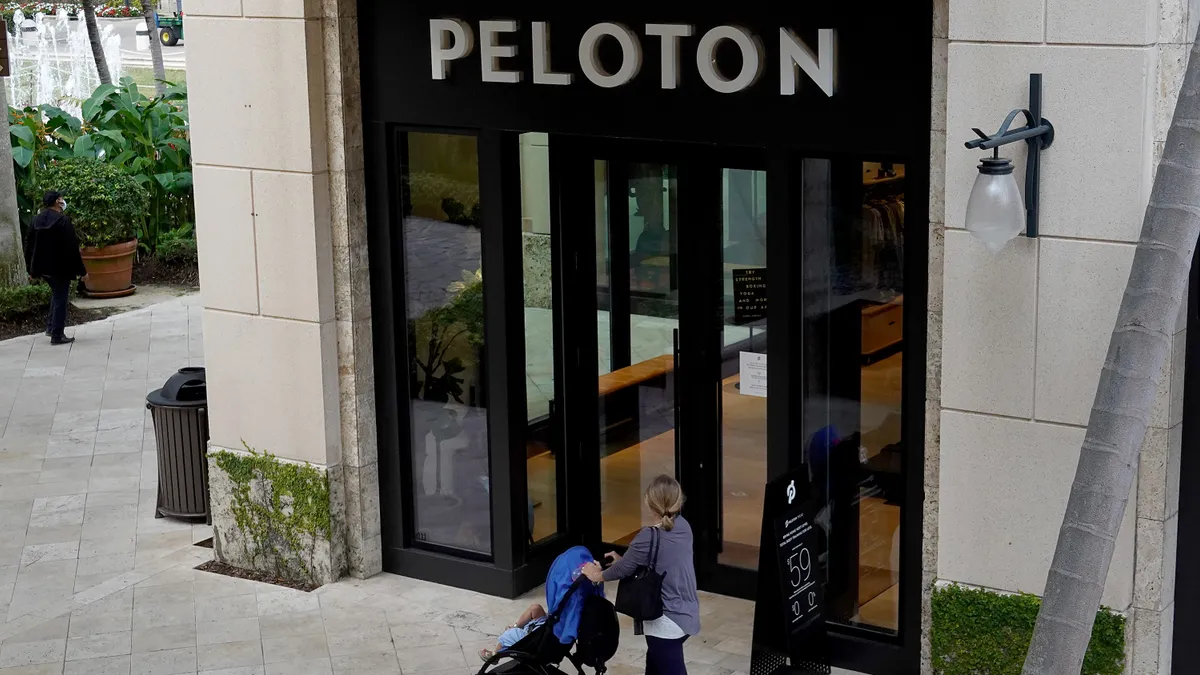Buy-online, pickup in-store (BOPIS) services are on the rise in the U.S. and abroad. According to data published early this year by Retail Systems Research and SPS Commerce, 61% of retailers worldwide now offer some kind BOPIS (a.k.a. "click-and-collect") service in an effort to make it easier for customers to purchase items online and retrieve them in the physical world.
Among the different types of BOPIS services, curbside pickup is perhaps the most curious, considering that it keeps customers out of stores—and, presumably, away from potential impulse buys and upselling opportunities.
Sears and the Container Store were early pioneers of curbside service, and Wal-Mart, Nordstrom, Target and a slew of grocery stores have piloted or instituted their own curbside programs in recent years. Their ranks now include CVS Health, which in April teamed with mobile commerce startup Curbside to launch CVS Express, a curbside pickup effort scheduled to roll out to all of its 8,000 U.S. locations by the end of the year. The nation’s second largest drugstore chain is already piloting the program in a few locations, including stores in San Francisco, Atlanta and Charlotte, NC, and CVS Chief Digital Officer Brian Tilzer told Retail Dive in email that the response has been “overwhelmingly positive.”
The CVS Express launch follows a much talked-about StellaService study published last year that argued that in-store pickup isn’t that much of a time-saver for consumers. But the premise of that research was flawed, it turns out. Shoppers don't view curbside pickup as a time-saver per se: For some, it’s a chance to get something they’ve purchased on the same day, without extra fees. For others, it’s an opportunity to accomplish an errand without lugging kids out of the car. For all, it meets heightened consumer expectations for convenient, low-cost delivery.
It’s also a reflection of how consumers are blurring online and offline shopping channels, experts say. That's something that many retailers have yet to fully appreciate because they're still grappling with their own omnichannel hangups, says Bridget Johns, head of customer experience at in-store analytics firm RetailNext.
“I think what’s happening in retail is that everyone’s been homing in on this notion that the best retail experience is to allow the consumer to be in charge of the purchase,” Johns told Retail Dive. “Click-and-collect, or curbside, is a great way to extend loyalty to your customer. And I think if retailers stop pushing their own channel complex onto the consumer, it’s going to be a win for everyone.”
How curbside beats same-day delivery
Amazon is widely seen as the catalyst behind the on-demand delivery trend, and many retailers have been scrambling to match the standard the online retail giant has set.
Amazon has aggressively shortened delivery times for its Prime members, first with free two-day shipping and more recently with same-day, two-hour and even one-hour delivery. It’s not usually a cheap option (Amazon’s “free” same-day delivery only comes after customers pay the $99 annual Prime membership fee), and the expense of same-day delivery may soon be going up, whether for retailers, their customers or the delivery startups themselves.
At any price, though, on-demand delivery remains a phenomenon largely relegated to big-city centers. A far more common situation for most Americans is that their favorite stores are often somewhere on their commute from work or along the path of their regular schedule of errands, says Jaron Waldman, co-founder and CEO of Curbside, which provides the customer-arrival detection software, inventory management tools and other white-label solutions powering CVS Express. (Target and Best Buy are also Curbside clients, and CVS is a Curbside investor as well.)
“We think, in the mainstream, people want the convenience as they’re driving around,” Waldman told Retail Dive. “Stores are located in these corridors that we drive anyway. Plus, curbside pickup usually is free—that’s a win, and a much bigger opportunity than same-day delivery.”
But from a brick-and-mortar retail perspective, making it easy for customers to stay in their cars seems counterintuitive. After all, 84% of Americans say they made an impulse buy last year according to a recent survey from CreditCards.com, a good bump from 2014, when it was still a healthy 75%. Plus, while mobile applications and social media would seem to encourage impulsive behavior, buying on a whim is still most likely to happen in a physical store: 79% of snap purchases take place under a store roof, compared to just 6% on mobile devices.
"Retailers need to have a clear vision of what click-and-collect is to them, because otherwise they take the risk of shooting themselves," said Adrien Nussenbaum, marketplace platform startup Mirakl's U.S. CEO and co-founder. "Selling a service that tells people 'You don’t need to come into my stores,' while at the same time defending the store model, is a bit schizophrenic. Click-and-collect should be one delivery option amongst all delivery options."
Retailers also must realize that it's first and foremost a customer-facing option, Nussenbaum contends. "Click-and-collect will never be successful if it’s driven by financial priorities on the retailer side," he said.
Done right, however, it's an option can go far in cementing loyalty, says Johns. “Curbside can keep [a customer] out of the store, sure,” she said. “These retailers have that leap of faith, that 'If we do the best for the consumer, she’ll do the best for us.' The thing to consider is the metrics that point to success, measuring loyalty and experience from a consumer perspective. The question should be ‘What is the value of an individual consumer?’ rather than ‘What is the value of an individual transaction?’”
At the Container Store, curbside pickup has been an option for years, done at first at the spontaneous request of a customer and more recently offered as a formal fulfillment option, according to John Thrailkill, the storage and organization solutions chain's vice president of store systems and business development there.
Worries about curbside service tempering customers' buying habits haven’t materialized, Thrailkill told Retail Dive. “If you’ve got a customer who needs something like [curbside pickup], I’m just going to figure it out,” Thrailkill told Retail Dive. “When you think about how the internet is changing things, it's meant that there are more people who realize they can ask for it. We’re trying to increase the frequency and we’re trying to commit her to make a purchase, and click and pickup and all that means that she’s going to be able to fit it into her schedule.”
CVS Health's Tilzer said executives there aren't worrying about keeping customers out of the store, either. Its drive-through pharmacy fulfillment—another form of curbside pickup—long ago assuaged those fears.
“This was a worry 20+ years ago with pharmacy drive-through, and it was unfounded,” Tilzer said in an email to Retail Dive. “We also see this added convenience as a way to create more visits to our store.”
Making curbside work for customers—and retailers
The single most important key to successful curbside pickup (or other BOPIS fulfillment options) is tight control and comprehensive knowledge of inventory, according to Thrailkill.
“The inventory thing was one of the things that has been one of our strengths over the years. We have an inventory-focused culture,” he said. “So the beauty is that we have really good controls and awareness of making sure we have accuracy at all times. If I have eight of something in the store, I’m confident that I really will have eight. There’s no way to do [curbside] without having this really buttoned up.”
Retailers also should create a dedicated curbside parking space, with signage that sets it apart. Extending those same signage graphics (or an actual photo of the store’s pickup space) to the retailer's mobile app or into its customer email also does wonders to help guide customers to the right spot, experts all say.
Staff associates should be trained in how to handle the orders and fulfillment smoothly, but both Waldman and Thrailkill say there’s rarely a need to dedicate employees to the service. For most retailers, it will be enough to simply incorporate the demands of curbside service—i.e., taking items from store or backroom shelves, packing, fulfillment, and delivery to the car—into employees' other assigned tasks.
Retailers must also orient curbside services in ways that work best for the customer, not for the store's own convenience, says Johns. Tucking curbside pickup in the back, where inventory is stored and delivered, may seem obvious from an in-house perspective, for example, but if it’s more difficult or unpleasant for the customer, it's not a good choice.
“The thing you have to be cautious of is not introducing more friction into the buying process,” Johns said. “If you have curbside, including the digital experience is really important—some kind of process that allows the customer to say, 'Here I am.’ You don’t want people waiting in their car very long. The busiest times for click-and-collect and pickup are going to be the same times that your stores are the busiest, so you have to plan for it.”
Most of all, retailers can never lose sight that click-and-collect options, and curbside in particular, are quintessential examples of how technology has shaped and transformed shopper expectations. Only when retailers lean in toward consumers, like flowers to the sun, are such operations likely to succeed.
“Talking about it being customer-focused is the right way to think about it,” Thrailkill said. “It’s not what we want to do—it’s what the customer wants to do. Yes, we’re a store-based retailer. But we’re first and foremost a retailer. So we expect to do what the customer is asking of us.”






















